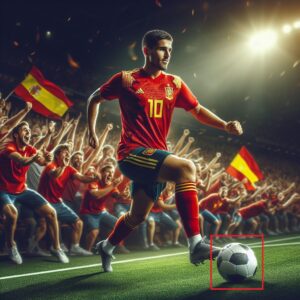The Art of the Box: Bounding Box Detection Explained
Bounding box detection is a computer vision technique that uses rectangular boxes to locate and size objects in images and videos. By analyzing pixels and patterns, the model not only identifies the object’s presence but also estimates its position and size, often working alongside object classification to pinpoint what the object is.

Bounding Box Detection: Pinpointing Objects in Images
Bounding box detection is a fundamental technique in computer vision aimed at identifying and precisely delineating objects within digital images. At its core, this method entails the precise localization of objects by encompassing them within rectangular frames known as bounding boxes. These bounding boxes serve as spatial references, providing information about the position, size, and orientation of objects relative to the image frame. The detection process involves analyzing the content of an image to identify regions of interest that potentially contain objects of significance, and then outlining these regions with bounding boxes.

Bounding boxes would be drawn around both the squirrel and the dog, creating rectangular frames that encompass each object. This allows the computer to precisely pinpoint their location within the image, enabling further analysis or tasks like image captioning or object recognition.
One of the primary objectives of bounding box detection is to enable machines to understand and interpret visual data, a task essential for a wide range of applications spanning various industries. From autonomous vehicles navigating through traffic to surveillance systems monitoring crowded environments, the ability to accurately detect and locate objects within images is critical for decision-making and interaction in automated systems. By employing bounding box detection algorithms, machines can effectively analyze visual inputs and respond accordingly, enhancing safety, efficiency, and functionality in numerous real-world scenarios.
The implementation of bounding box detection typically involves the utilization of sophisticated machine learning techniques, particularly deep learning methodologies such as convolutional neural networks (CNNs). CNNs are well-suited for this task due to their ability to automatically learn hierarchical features from raw pixel data, enabling robust object recognition and localization. Through extensive training on annotated datasets containing images with corresponding bounding box annotations, CNN-based detectors can effectively learn to identify objects of interest and accurately delineate their boundaries within images.
The Power of the Box: Bounding Box Detection in Action
 Bounding box detection, a cornerstone of computer vision, plays a vital role in unlocking the potential of images and videos. Imagine a scene: a busy city street. Bounding boxes can be drawn around each car, pedestrian, and traffic light. This seemingly simple act of drawing a box empowers computers to “see” the world in a structured way. Here’s how this technology is transforming various fields.
Bounding box detection, a cornerstone of computer vision, plays a vital role in unlocking the potential of images and videos. Imagine a scene: a busy city street. Bounding boxes can be drawn around each car, pedestrian, and traffic light. This seemingly simple act of drawing a box empowers computers to “see” the world in a structured way. Here’s how this technology is transforming various fields.
Firstly, bounding boxes are the workhorses of object recognition. By identifying and locating objects within an image or video frame, computers can then be trained to recognize them. This is crucial for self-driving cars, which use bounding boxes to detect pedestrians, vehicles, and traffic signals, allowing them to navigate safely. Similarly, facial recognition systems rely on bounding boxes to locate faces before analyzing their features.

Secondly, bounding box detection fuels the fire of image and video analysis. By pinpointing objects of interest, computers can track their movement, analyze interactions, and even gather insights. For instance, sports analytics leverage bounding boxes to track players on the field, measure their speed and distance travelled, and generate valuable statistics. Similarly, security systems employ bounding boxes to detect intruders within a designated area, triggering alarms and alerting authorities.
Thirdly, bounding box detection is a critical step in tasks like image segmentation and object counting. By isolating individual objects, computers can then be programmed to differentiate them from the background or count their exact number. This is beneficial for tasks like inventory management in warehouses, where bounding boxes can identify and count different types of products on shelves.
The power of bounding box detection isn’t limited to just these examples. As computer vision continues to evolve, so too will the applications of this technology. From content moderation on social media platforms to autonomous robots in manufacturing, bounding boxes are poised to play an increasingly important role in our digital future.
In conclusion, bounding box detection represents a crucial component of computer vision systems, enabling the precise localization and delineation of objects within digital images. By leveraging deep learning techniques and annotated training data, bounding box detection models can accurately identify objects of interest and provide spatial information essential for various applications ranging from autonomous navigation to object recognition. For high-accuracy results, services like FasterLabeling can be particularly useful. FasterLabeling employs real people to meticulously create bounding boxes, ensuring superior precision compared to solely machine-generated annotations. FasterLabeling, with its focus on accuracy and handling of sensitive data, presents a valuable asset for models requiring training data for bounding box detection at scale.
References
Moon, J., Jeon, M., Jeong, S., & Oh, K. Y. (2024). RoMP-transformer: Rotational bounding box with multi-level feature pyramid transformer for object detection. Pattern Recognition, 147, 110067.
Ma, Y., Zhou, D., He, Y., Zhao, L., Cheng, P., Li, H., & Chen, K. (2023). Aircraft-LBDet: Multi-Task Aircraft Detection with Landmark and Bounding Box Detection. Remote Sensing, 15(10), 2485.
Yu, D., Guo, H., Zhao, C., Liu, X., Xu, Q., Lin, Y., & Ding, L. (2023). An anchor-free and angle-free detector for oriented object detection using bounding box projection. IEEE Transactions on Geoscience and Remote Sensing.
Hashmi, K. A., Pagani, A., Stricker, D., & Afzal, M. Z. (2023). Boxmask: Revisiting bounding box supervision for video object detection. In Proceedings of the IEEE/CVF Winter Conference on Applications of Computer Vision (pp. 2030-2040).
Kapitanov, A., Kvanchiani, K., Nagaev, A., Kraynov, R., & Makhliarchuk, A. (2024). HaGRID–HAnd Gesture Recognition Image Dataset. In Proceedings of the IEEE/CVF Winter Conference on Applications of Computer Vision (pp. 4572-4581).
